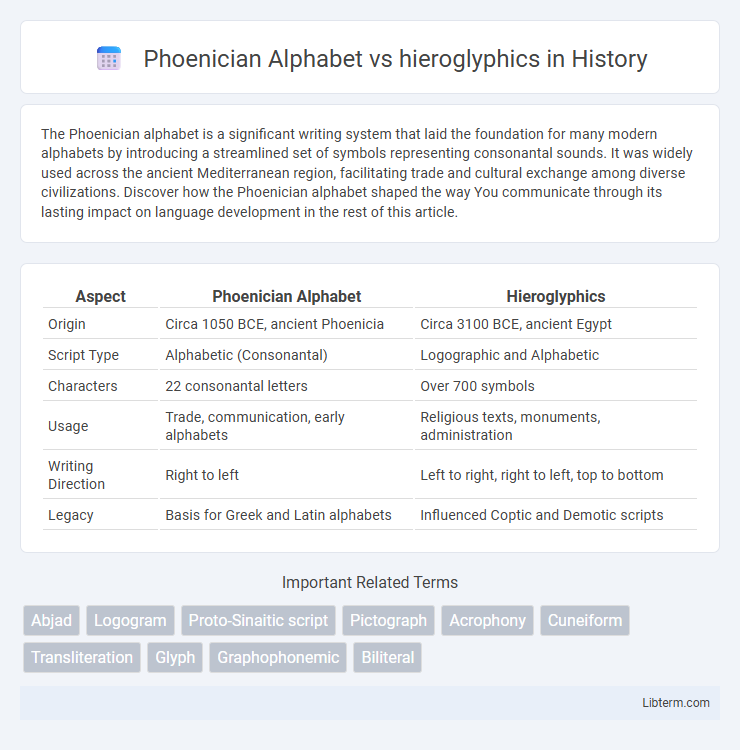The Phoenician alphabet is a significant writing system that laid the foundation for many modern alphabets by introducing a streamlined set of symbols representing consonantal sounds. It was widely used across the ancient Mediterranean region, facilitating trade and cultural exchange among diverse civilizations. Discover how the Phoenician alphabet shaped the way You communicate through its lasting impact on language development in the rest of this article.
Table of Comparison
| Aspect | Phoenician Alphabet | Hieroglyphics |
|---|---|---|
| Origin | Circa 1050 BCE, ancient Phoenicia | Circa 3100 BCE, ancient Egypt |
| Script Type | Alphabetic (Consonantal) | Logographic and Alphabetic |
| Characters | 22 consonantal letters | Over 700 symbols |
| Usage | Trade, communication, early alphabets | Religious texts, monuments, administration |
| Writing Direction | Right to left | Left to right, right to left, top to bottom |
| Legacy | Basis for Greek and Latin alphabets | Influenced Coptic and Demotic scripts |
Introduction to Ancient Writing Systems
The Phoenician alphabet, originating around 1050 BCE, is considered one of the earliest phonetic writing systems, using symbols to represent sounds rather than ideas, which simplified writing and reading compared to complex hieroglyphics. Egyptian hieroglyphics, developed around 3200 BCE, combined logographic and alphabetic elements, utilizing intricate symbols to convey both sounds and meanings, making it more visually detailed but harder to learn. The shift from hieroglyphics to the Phoenician alphabet marked a significant evolution in ancient writing systems, influencing many modern alphabets.
Origins of the Phoenician Alphabet
The Phoenician alphabet originated around 1050 BCE as a simplified, consonantal script derived from Proto-Sinaitic writing, designed to facilitate trade and communication across the Mediterranean. Unlike Egyptian hieroglyphics, which combined logographic and alphabetic elements with complex symbols, the Phoenician script used a set of 22 letters representing individual sounds, marking a significant evolution in writing systems. This innovation laid the foundation for many modern alphabets, including Greek and Latin, by emphasizing phonetic representation over pictorial symbols.
Development of Egyptian Hieroglyphics
Egyptian hieroglyphics developed around 3100 BCE as a complex system of pictorial writing used for religious texts, monumental inscriptions, and administrative records. Unlike the Phoenician alphabet, which utilized a streamlined set of phonetic symbols primarily representing consonants, hieroglyphics combined logographic, syllabic, and alphabetic elements to convey meaning through intricate visuals. This multifaceted script marked a significant advancement in written communication by enabling detailed expression of linguistic and cultural concepts over millennia in ancient Egypt.
Structural Differences: Alphabet vs. Symbols
The Phoenician alphabet consists of a standardized set of 22 consonantal letters representing individual sounds, enabling efficient and flexible written communication. In contrast, Egyptian hieroglyphics combine logographic, syllabic, and alphabetic elements through intricate pictorial symbols that convey both phonetic and semantic information. The alphabetic nature of the Phoenician script allowed for easier adoption and adaptation by subsequent writing systems, while hieroglyphics required more extensive learning due to their complex symbol system.
Phonetic Representation in Both Systems
The Phoenician alphabet revolutionized writing by representing sounds with a limited set of symbols, each corresponding to specific consonantal phonemes, enabling efficient phonetic transcription and facilitating literacy. Hieroglyphics combined logographic and phonetic elements, using symbols to convey sounds, syllables, or entire words, making the system highly complex but rich in semantic nuance. Phoenician's streamlined phonetic approach directly influenced later alphabets, while hieroglyphics maintained a multifaceted script blending phonetic and pictorial meanings.
Writing Materials and Methods
The Phoenician alphabet was primarily inscribed on papyrus, parchment, and stone using reed pens or chisels, promoting efficient and widespread record-keeping. Hieroglyphics were predominantly carved into temple walls, tombs, and monuments with chisels or painted on papyrus with brushes, requiring more labor-intensive techniques. The simplicity of the Phoenician script facilitated faster writing on portable materials, contrasting with the complex and time-consuming hieroglyphic carvings.
Accessibility and Literacy Rates
The Phoenician Alphabet's simplified set of 22 consonantal symbols significantly enhanced accessibility compared to the complex and pictorial nature of Egyptian hieroglyphics, which involved hundreds of symbols. This reduction in complexity facilitated higher literacy rates among the general population, as learning the alphabet required less time and effort. Consequently, the Phoenician script became a foundational influence on many modern alphabets, promoting widespread literacy across different cultures.
Influence on Later Writing Systems
The Phoenician alphabet significantly influenced later writing systems by providing a streamlined, phonetic script that formed the basis for Greek and Latin alphabets, shaping modern Western languages. Hieroglyphics, while complex and primarily pictographic with ideographic elements, contributed to the development of scripts like Demotic and Coptic, influencing Egyptian and subsequent Christian textual traditions. The Phoenician system's adaptability and efficiency led to widespread adoption, whereas hieroglyphics remained specialized and ceremonial, limiting its impact on broader script evolution.
Cultural and Historical Significance
The Phoenician alphabet, representing one of the earliest known phonetic writing systems, significantly influenced the development of modern alphabets due to its simplicity and adaptability, contrasting with the complex pictorial nature of Egyptian hieroglyphics, which were deeply intertwined with religious and ceremonial contexts. Hieroglyphics served as a sacred script primarily used by priests and scribes to document religious texts and royal decrees, reflecting the sociopolitical structure of ancient Egypt. The Phoenician system's practicality facilitated widespread trade and communication across the Mediterranean, promoting cross-cultural exchange and laying the groundwork for alphabetic literacy in Western civilizations.
Legacy and Modern Relevance
The Phoenician alphabet is the ancestor of many modern writing systems, including Greek, Latin, and Arabic scripts, making it fundamental to contemporary literacy and communication. Hieroglyphics, while primarily symbolic and less adaptable, significantly influenced art, religion, and cultural documentation in ancient Egypt but hold limited practical use today. The legacy of the Phoenician alphabet endures in the widespread global use of alphabetic writing, shaping education, technology, and information dissemination worldwide.
Phoenician Alphabet Infographic

 libterm.com
libterm.com